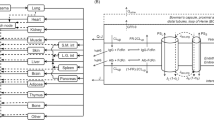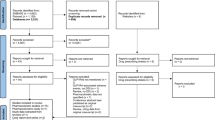Summary
The pharmacokinetics of alinidine was investigated in two groups of volunteers: Group I (N=5) received on two different occasions single doses of14C-labelled drug given orally (40 mg) or intravenously (10 mg); Group II (N=6) received single oral doses 10, 30 or 90 mg dissolved in 20 ml water. The samples from Group I were analysed by two different and independent methods (RIA and counting total radioactivity). The results obtained by the two methods were identical, since the compound was not metabolized. The plasma concentrations and renal excretion data obtained from both groups were individually fitted to an open three compartment model. Independent of the route of administration and of the doses given, similar pharmacokinetic parameters were calculated for each group and each trial. The half lives of the distribution and elimination phases were t1/2α: 36–41 s, t1/2β : 9.9–11.1 min and t1/2γ: 2.7–3.8 h. There was a linear relationship between the dose administered and the resulting areas under the plasma concentration curves (AUC). Following a lag period (τ=0.19–0.22 h), the peak plasma concentration was reached 0.6–1.2 h after oral administration. Oral alinidine was 100% bioavailable.
Similar content being viewed by others
References
Kobinger W, Lillie C, Pichler L (1979a) N-allylderivative of clonidine, a substance with specific bradycardic action at a cardiac site. Naunyn-schmiedeberg's Arch Pharmacol 306: 255–262
Kobinger W, Lillie C, Pichler L (1979b) Cardiovascular action of N-allyl-clonidine (St 567), a substance with specific bradycardic action. Eur J Pharmacol 58: 141–150
Traunecker W, Walland A (1980) Haemodynamic and electrophysiologic actions of alinidine in the dog. Arch Int Pharmacodyn Ther 224: 68–72
Harron DWG, Riddel JG, Shanks RG (1981) Alinidine reduces heartrate without blockade of beta-adrenoceptors. Lancet 1: 351
Kasper W, Meinertz T, Treese N, Kersting F, Pop T, Jähnchen E (1981) Clinical Electrophysiological Properties of N-Allyl-Clonidine (St 567) in Man. J Cardiovasc Pharmacol 3: 39–47
Arndts D, Leb G, Förster H-J (1981a) Pharmacokinetics and metabolism of14C-labelled alinidine in man and dog. Eur J Metab Pharmacokinet (in press)
Arndts D, Stähle H (1981b) Development and quality control of a radioimmunoassay for alinidine. J Pharm Meth (in press)
Wolf M, Heinzel G, Koss FW (1977) Pharmacokinetic / II. Teil: Verallgemeinerte theoretische Darstellung der vollständigen Interpretation linearer Kompartmentmodelle beliebiger Struktur. Arzneim-Forsch (Drug Res) 27: 900–1004
Author information
Authors and Affiliations
Rights and permissions
About this article
Cite this article
Arndts, D., Warnkross, H., Rominger, K.L. et al. Proof of the linearity of the pharmacokinetics of alinidine in man. Eur J Clin Pharmacol 21, 201–207 (1981). https://doi.org/10.1007/BF00627921
Received:
Accepted:
Issue Date:
DOI: https://doi.org/10.1007/BF00627921




